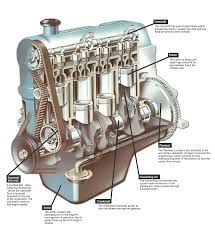
Car Engine Parts, When you start your car and hit the road, you rely on a complex machine to power your journey. At the heart of this machine is the engine—an intricate assembly of components working together to convert fuel into motion. Understanding car engine parts is essential not only for car enthusiasts but also for everyday drivers who want to better appreciate how their vehicles function.
What Is a Car Engine?
A car engine is the powerhouse of a vehicle. It’s a sophisticated machine designed to convert fuel into mechanical energy, which turns the wheels and propels the car forward. This process involves a series of controlled explosions, movement of mechanical parts, and the transfer of energy—all made possible by the many car engine parts working in harmony.
Key Car Engine Parts and Their Functions
Let’s break down some of the most important car engine parts:
1. Cylinder Block
The cylinder block is the foundation of the engine. It houses the cylinders where fuel combustion occurs. Typically made from cast iron or aluminum, the cylinder block contains passageways for coolant and oil, helping manage engine temperature and lubrication.
2. Pistons
Pistons move up and down within the cylinders, compressing the fuel-air mixture and transmitting the force of combustion to the crankshaft. Each piston is connected to a connecting rod, which plays a key role in transferring motion.
3. Crankshaft
The crankshaft converts the linear motion of the pistons into rotational motion that turns the wheels. It is one of the most critical car engine parts for driving the vehicle’s mechanical functions.
4. Camshaft
The camshaft operates the intake and exhaust valves, ensuring they open and close at the right times. This timing is essential for efficient engine performance and is controlled by a timing belt or chain.
5. Valves
There are two types of valves: intake and exhaust. Intake valves allow the air-fuel mixture into the combustion chamber, while exhaust valves let out the burnt gases. These valves must open and close with precise timing to maintain engine efficiency.
6. Spark Plugs
In gasoline engines, spark plugs ignite the air-fuel mixture inside the cylinder. This ignition initiates the combustion process, producing the power needed to move the vehicle.
7. Fuel Injector
Modern engines use fuel injectors to spray a fine mist of fuel into the combustion chamber. The fuel injector ensures the right amount of fuel is delivered for optimal performance and efficiency.
8. Timing Belt or Chain
This part synchronizes the rotation of the crankshaft and camshaft, ensuring that valves open and close in time with piston movements. A broken timing belt can result in serious engine damage.
9. Oil Pan
Located at the bottom of the engine, the oil pan stores the engine oil that lubricates all moving parts. Proper lubrication reduces friction and prevents overheating.
10. Engine Control Unit (ECU)
The ECU is the brain of the engine, monitoring and adjusting various parameters such as fuel injection, ignition timing, and idle speed for optimal performance.
Why Knowing Car Engine Parts Matters
Understanding car engine parts can help you maintain your vehicle better, diagnose issues early, and communicate more effectively with mechanics. Regular maintenance—such as changing oil, replacing filters, and checking spark plugs—can prolong the life of these engine components and keep your car running smoothly.
Conclusion
Car engine parts each play a vital role in the performance and reliability of your vehicle. By familiarizing yourself with these components, you not only become a more informed car owner but also contribute to the long-term health and efficiency of your vehicle. Whether you’re troubleshooting a problem or simply curious about what happens under the hood, knowledge of car engine parts is a valuable tool for every driver.
You Might Also Like These:

Leave A Comment